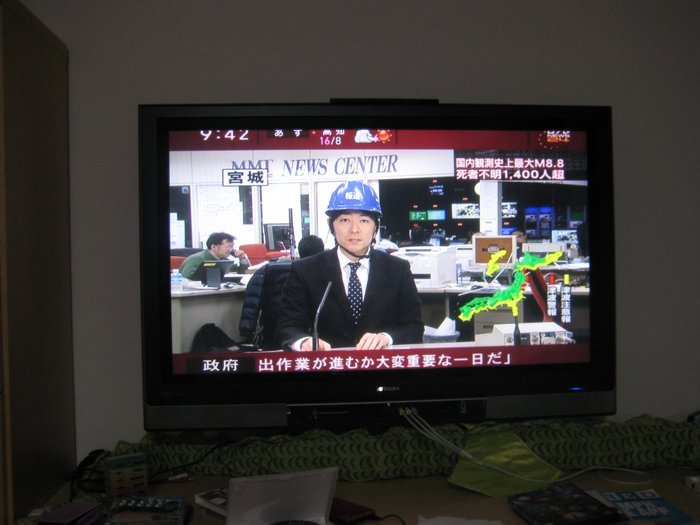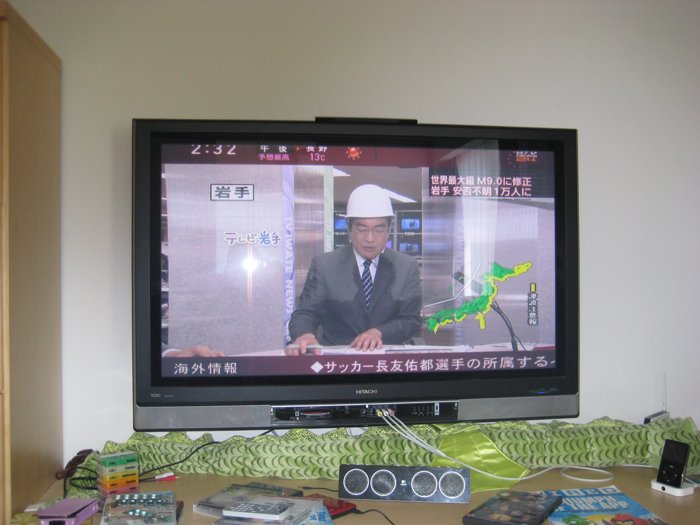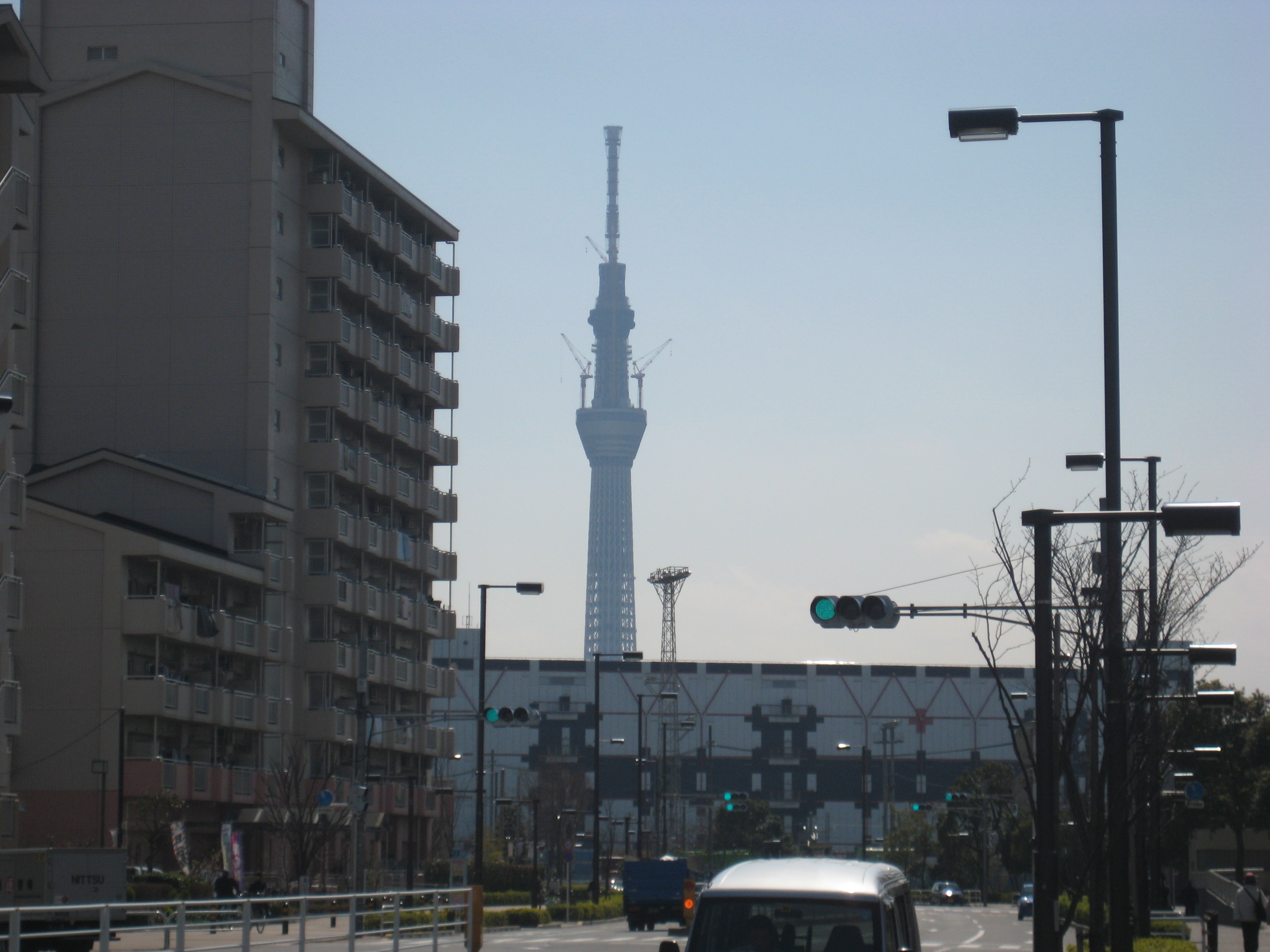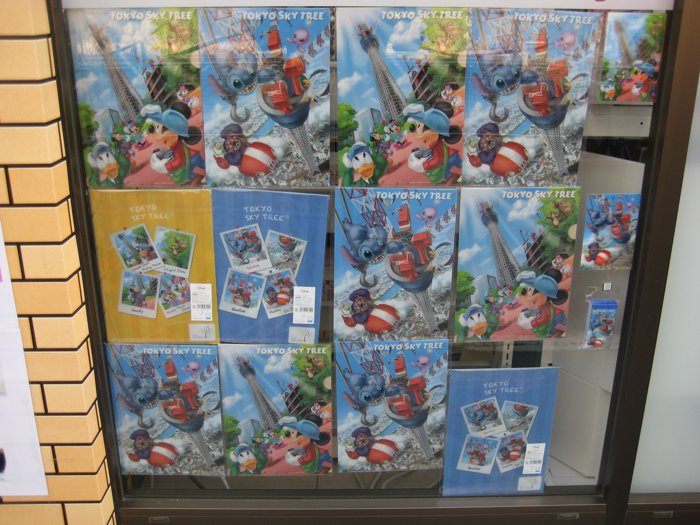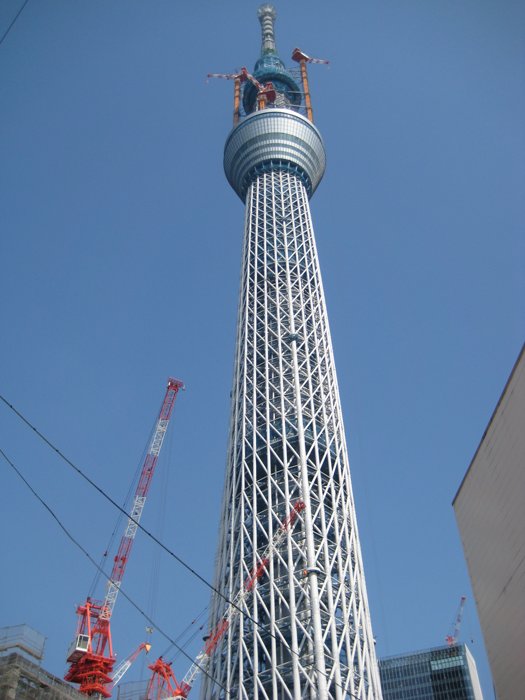Yesterday’s post told the story of my earthquake day. Now I’ve taken some time to pull the pictures off my camera, and tell it in a bit more detail.
So here’s the walkthrough again.
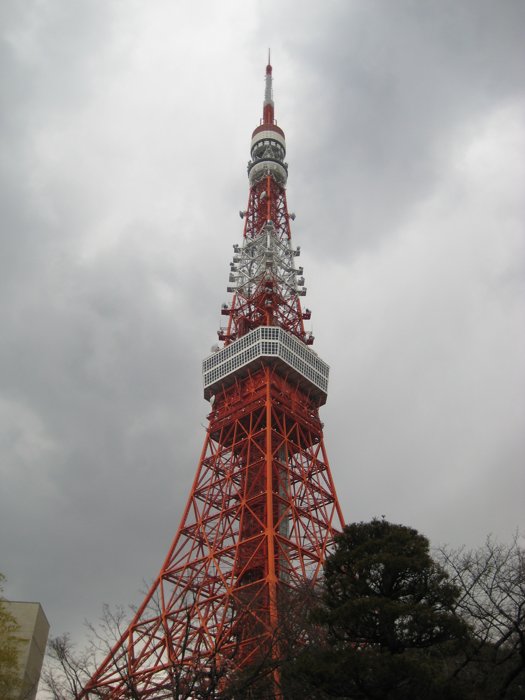
This is the Tokyo Tower, before we went up it. It’s not well captured, as it’s too big to photograph well once you’re close to it. You can see the big square observation deck (150m up), and the smaller circular observation deck another 100m further up. This was taken at 2:25.
We bought our tickets, went up to the first deck, had a wander around and enjoyed the view, and waited until our ticket numbers were shown on the big sign, so that we could go up to the upper deck.
The quake hit while we were in the lift – we could feel it wobbling around as we went up. But then lifts are often a bit shaky, so I didn’t think much about it. I was much more surprised when the observation deck was moving around. Not being a local, I assumed we were blowing in the wind. But it quickly became clear that this was an earthquake. But there was no panic, despite the shaking – there was no screaming at all, and only one person in tears (who I didn’t notice – Karen told me this). To my shame, I was quite excited, as I didn’t notice the quake on Tuesday, and therefore hadn’t experienced an earthquake before. The other surprise was that it kept going for so long – minutes of it. But of course, we assumed that it was a small quake, magnified by the tall spindly building.
We were the last group of people to come up in the lift, and once the quake happened they were shut down, so we spent quite some time up there. There was an American family, who had left their son on his own on the lower level, because he hadn’t wanted to go higher. Needless to say they were very worried about him, on his own and unable to communicate. But the staff were able to put them in touch with each other on the internal phone, and they felt a bit better. His sister was quite unnerved by it all too.
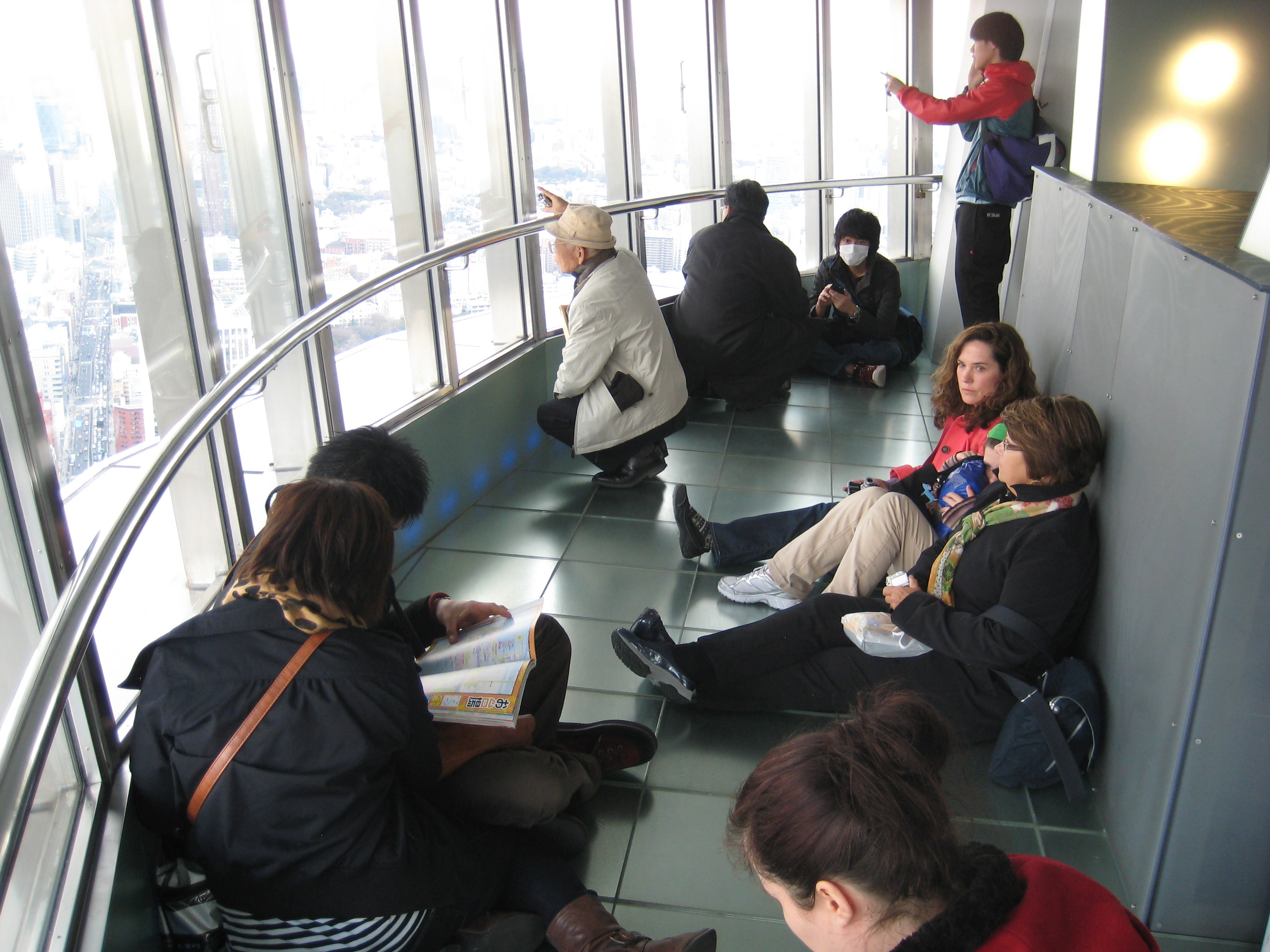
You can see the Americans on the right are quite concerned looking. But one of the Janapese guys has managed to get a signal, and is looking out the window talking on his phone, while another couple are reading a magazine.
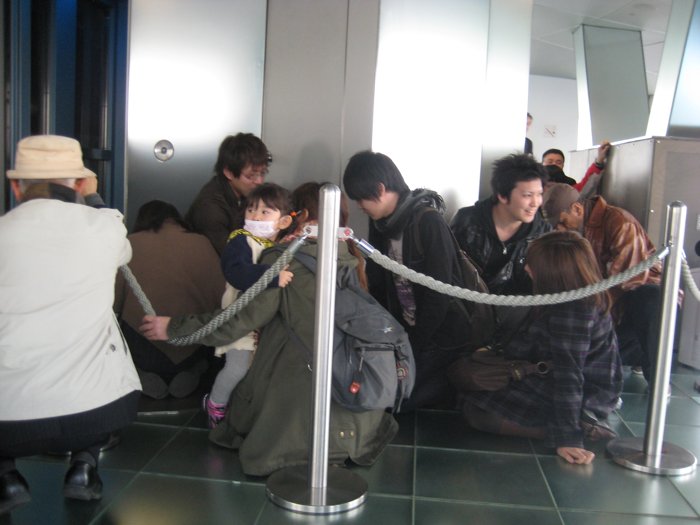
This was during another aftershock. The little girl doesn’t look very happy, but she’s okay. And the guy facing us is clearly enjoying it at least a bit.
But round the other side of the deck were about 25 young children, visiting in a group. There was no, panic, no screaming, tantrums or crying – they were amazing, and full marks to their teachers who kept them calm for over an hour while we were up there. This is a quick sneaky snap of them, all in their cute uniforms.
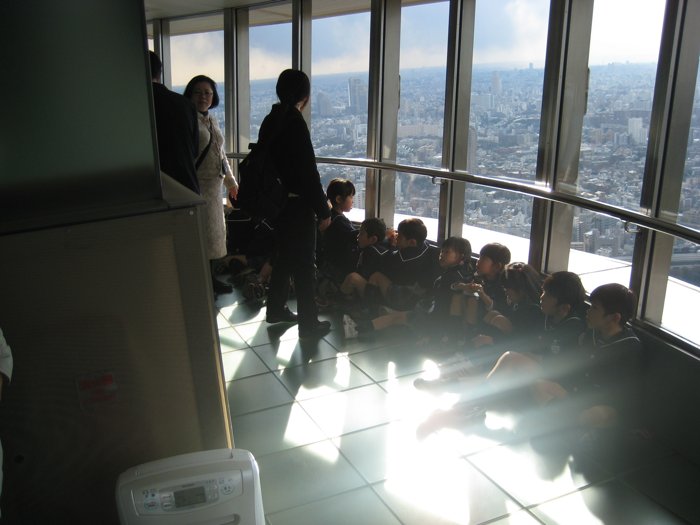
That’s what was happening inside the Tower. What was happening outside? After all, we had a great view over the city. What could we see? During the main quake, all traffic stopped moving. We noticed that didn’t happen for any of the aftershocks. We could see the rainbow bridge, and apparently it did wobble at some stage, but I missed that. The main thing everyone noticed and worried about was a fire in Odaiba.
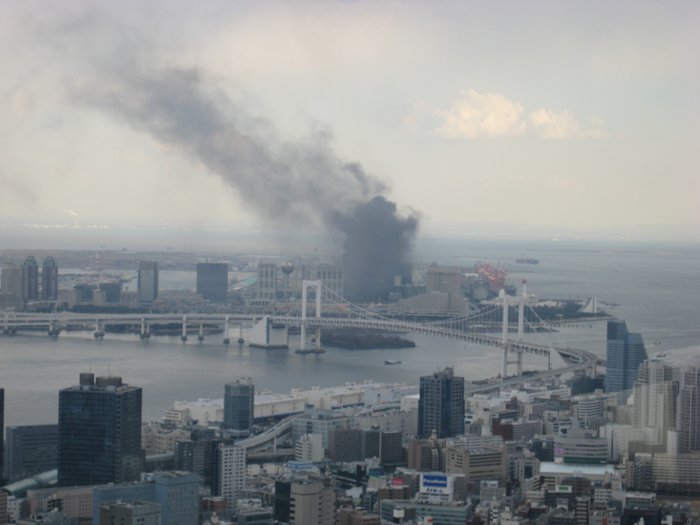
The black smoke looks bad, but this fire was out by the time we left.
And the thing I noticed was this building with a huge water tank on the roof. After each shake, the sloshed about. It’s a terrible photo from my small camera, but it was cool to watch.
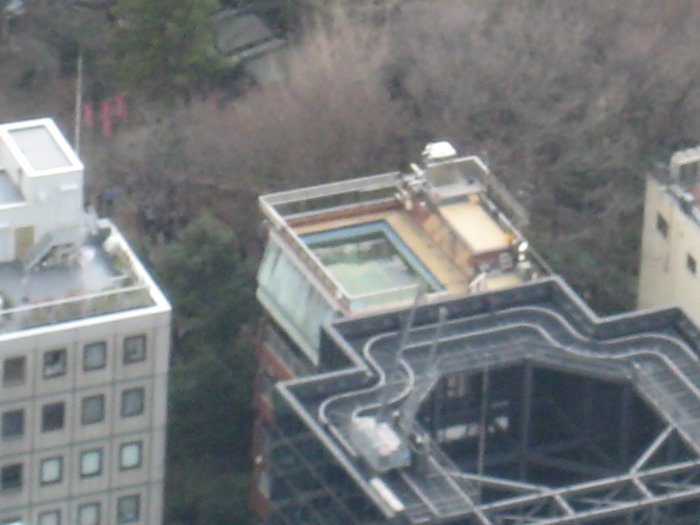
Meanwhile, the staff were trying to work out what to do with us. The lifts were out of action until they could be safety checked. There were stairs to go down, but there were 600 of them, and they were very reluctant for us to use them. I had visions of us all having to carry 2 children each. The managers came round frequently to apologise, but I think it’s fair to say we weren’t blaming him for the earthquake. And the cleaning lady kept going round and cleaning the windows and polishing the lift doors (I wish I’d got a picture of her). After a while, another manager made it up the stairs (he looked wrecked), with a lift technician. And after not too much longer, they got the lifts working, and started to bring us down. We were in the third group to leave, after having been up there for about an hour and a half.
When we got down to the main observation deck, it had already been evacuated, and was deserted except for the staff who were there to direct us and give us our refund (yes really, they did). We then walked down the many stairs, and reached the ground at last. I have some pictures of the tower afterwards, but it looks the same. Okay, that’s not quite true. I’ve had another look, and you can actually see that the antenna at the top of the tower is leaning afterwards. But I can’t recrop the picture to show it here right now. Just trust me.
Having made it to the safety of the ground, we decided to head for Marty’s office, where we could either seek shelter in his office, or get the train home. The walk back was odd. There were plenty of bikes on stands that hadn’t even fallen over, so it didn’t look serious. We say one pile of cardboard boxes that had fallen, and 2 broken windows, but that was it. But we could see that shops had closed, and the trains weren’t running. The lack of trains was a worry – central Tokyo contains literally millions of people of work there, and commute in and out, so the trains are an essential part of daily life. With no transport, there would soon be a huge population on the move.
So we went to Marty’s office, in the Mori Tower. This is one of those buildings that they make documentaries about – it is as earthquake proof as mankind can make it, and therefore one of the safest places to be in the city. We were able to get into the foyer, and there we waited. There was a good number of people there, employees who were on their way in or out when the lifts were shut down. It was here that we started to make contact with the outside world. There was no television, and we couldn’t make phone calls or send or receive text messages, but Karen was able to get a 3G internet connection on her phone, and so she was quickly able to get a view of what was happening from her friends on twitter. Twitter turned out to be amazing – friends were checking in, letting people know they were okay, reporting what had happened to them, and reporting on the many aftershocks.
Once the lifts starting going again, Marty was able to come down and meet us, and we were able to join him in his office. There we saw news for the first time, and it went from being an adventure to a horror story when we saw the impact of the tsunami in the north. But Marty’s company was excellent, providing food for the many employees who had stayed there, as well as really good emergency packs containing a helmet, water, food, a map, glowsticks, gloves, and lots of other useful stuff.
We stayed there until close to midnight, still feeling aftershocks even in that building. By that time the trains were moving again, so we decided to go home. Fortunately, the line to Karen and Marty’s was running almost all the way, and only stopped a couple of times for aftershocks. So we got as far as Ueno, then joined the crowd walking home.
It was very orderly – lots of people, calmly making their way. The roads were full of cars, with more traffic than usual in the first place, and many major roads closed because they are elevated, and shouldn’t be used until they had been checked out. But as has been widely reported, all the usual traffic rules were being observed, and pedestrians were waiting for the green man. Small shops were still open, including a car rental place, which I though was odd. It took us about an hour to walk home, and although it was cold, it was a pleasant enough night for a walk (I kept thinking that if this was Northern Ireland, we’d have to do it in the rain).l
When we made it home and checked for damage, we found the following: – 1 guitar fallen over, 1 ornament fallen over, some drawers open and 1 card fallen over. The gas was off, but water and power were fine.
So although our day was dramatic and exciting, we were never in any danger, and didn’t even realise that there it had been a serious earthquake until pretty late in the day.
